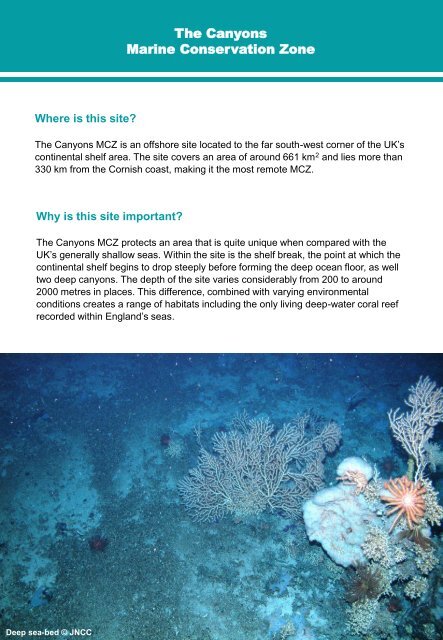The Canyons MCZ - JNCC - Defra
The Canyons MCZ - JNCC - Defra
The Canyons MCZ - JNCC - Defra
You also want an ePaper? Increase the reach of your titles
YUMPU automatically turns print PDFs into web optimized ePapers that Google loves.
<strong>The</strong> <strong>Canyons</strong><br />
Marine Conservation Zone<br />
Where is this site?<br />
<strong>The</strong> <strong>Canyons</strong> <strong>MCZ</strong> is an offshore site located to the far south-west corner of the UK’s<br />
continental shelf area. <strong>The</strong> site covers an area of around 661 km 2 and lies more than<br />
330 km from the Cornish coast, making it the most remote <strong>MCZ</strong>.<br />
Why is this site important?<br />
<strong>The</strong> <strong>Canyons</strong> <strong>MCZ</strong> protects an area that is quite unique when compared with the<br />
UK’s generally shallow seas. Within the site is the shelf break, the point at which the<br />
continental shelf begins to drop steeply before forming the deep ocean floor, as well<br />
two deep canyons. <strong>The</strong> depth of the site varies considerably from 200 to around<br />
2000 metres in places. This difference, combined with varying environmental<br />
conditions creates a range of habitats including the only living deep-water coral reef<br />
recorded within England’s seas.<br />
Deep sea-bed © <strong>JNCC</strong>
What does this Marine Conservation Zone protect?<br />
Large areas of deep-sea bed are protected within the site. This habitat is<br />
typically made up of a range of seabed types including bedrock, gravel and mud<br />
or limestone pavements.<br />
Cold-water coral reefs are found around the world in deep, cold water and<br />
typically form on slopes and underwater mountains where subsurface currents<br />
bring plentiful food supplies. Within the site there is a patch of cold-water coral<br />
growing on one of the canyon walls. <strong>The</strong> reefs provide a source of food and<br />
shelter for many animals such as fish, sea urchins, anemones and sponges,<br />
and additionally they are also thought to act as breeding grounds for<br />
commercially important fish species.<br />
Cold-water corals can live for a very long time but require protection as they are<br />
extremely slow growing, at a rate of about 6 mm a year. This slow growth,<br />
combined with their brittle skeletons, means the reefs are particularly vulnerable<br />
to damage from a variety of pressures.<br />
Cold-water coral reefs © <strong>JNCC</strong><br />
Features<br />
Cold-water coral reefs<br />
Deep-sea bed<br />
General management approach<br />
Recover to favourable condition<br />
Recover to favourable condition
Who will manage Marine Conservation Zones?<br />
Many activities within the marine environment are regulated through marine licences.<br />
More information regarding the marine licensing process in relation to <strong>MCZ</strong>s can be<br />
found on the MMO website www.marinemanagement.org.uk/licensing/marine.htm<br />
Other activities are regulated through different mechanisms. For example fishing<br />
activities are managed through European legislation, national statutory instruments,<br />
byelaws and self-imposed voluntary agreements. Similar arrangements are in place<br />
to manage the range of activities that may impact <strong>MCZ</strong>s including pollution, coastal<br />
development and recreation.<br />
Management of sites is currently being prioritised nationally according to the potential<br />
or actual adverse impacts of activities on the features designated in relation to fishing<br />
activities. This prioritisation will be further refined at a local level taking into account<br />
relevant information and will guide regulators to those sites which may need<br />
protection before others.<br />
Any management measures that are required for <strong>MCZ</strong>s will be applied on a case-bycase<br />
basis. Management measures will be implemented at sites most at risk of<br />
damage first, regulating only those activities which have a detrimental impact on the<br />
features. In cases where there is a high risk to designated features being damaged<br />
emergency measures may be put in place to ensure the protection of vulnerable<br />
habitats and species.
What happens now this site has been designated?<br />
<strong>The</strong> site specific information below provides an overview of which activities may<br />
be affected by the designation of the <strong>MCZ</strong> and the current management<br />
measures. As with all management measures, they may, of course, be subject<br />
to change in the light of new evidence becoming available.<br />
Current activities identified at this site which could be affected include the UK<br />
and EU commercial fisheries sector (predominately mobile gear).<br />
As this site is offshore (over 12nm from the coastline) management measures<br />
will need to be proposed and agreed through the European Commission in<br />
accordance with the Common Fisheries Policy, applying to UK and non-UK<br />
fishing vessels alike. <strong>Defra</strong> will coordinate input from the MMO and <strong>JNCC</strong><br />
before formally submitting proposals to the EC. <strong>The</strong> MMO will be the lead<br />
authority regarding implementation and compliance of those measures. All<br />
current relevant national and EU fisheries legislation apply to this site such as<br />
Hake Recovery and Western Waters control measures.<br />
Further information is available at<br />
www.marinemanagement.org.uk/fisheries/index.htm<br />
Where can I find out further information?<br />
An interactive map showing this <strong>MCZ</strong>s and other marine protected areas is<br />
available at http://jncc.defra.gov.uk/page-5201<br />
Additional information about this site and other <strong>MCZ</strong>s is available at<br />
https://www.gov.uk/government/policies/protecting-and-sustainably-using-themarine-environment<br />
and within <strong>JNCC</strong>‘s advice available at http://jncc.defra.gov.uk/page-6460<br />
© <strong>Defra</strong> 2013
Annex: Management<br />
Lead organisation<br />
Activities<br />
Inshore Fisheries<br />
and Conservation<br />
Authorities (IFCAs)<br />
• Fisheries (0-6nm) including commercial fisheries and recreational fishing<br />
activities such as sea angling<br />
For further information visit www.association-ifca.org.uk<br />
Marine<br />
Management<br />
Organisation<br />
(MMO)<br />
Environment<br />
Agency (EA)<br />
• Fisheries (management) (6-12nm)<br />
• Fisheries (enforcement) national and EU legislation<br />
• Licensable activities such as deposit and removal activities below mean<br />
high water springs, including subsea cables (up to 12nm), construction<br />
(including renewables

















